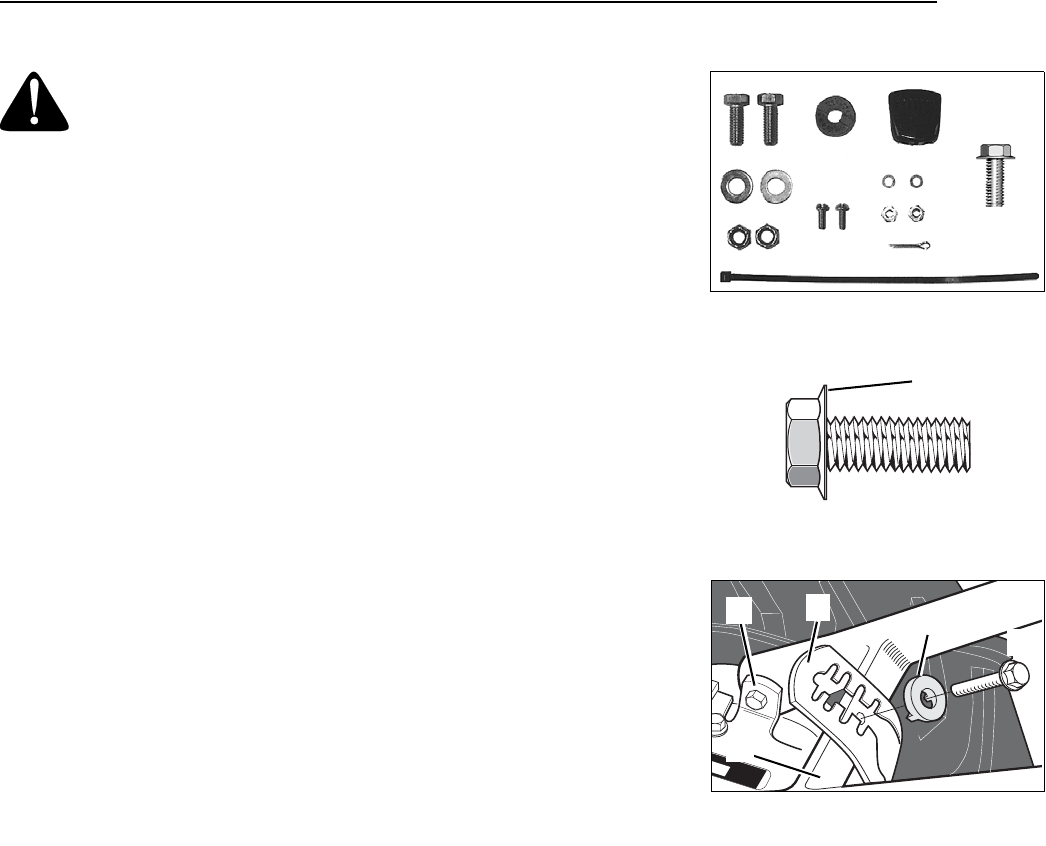
6
WARNING: To prevent
personal injury or property
damage, do not start the engine
until all assembly steps are
complete and you have read
and understand the safety and
operating instructions in this
Manual.
Introduction
Carefully follow these assembly steps to
correctly prepare your tiller for use. It is
recommended that you read this Section in
its entirety before beginning assembly.
Inspect unit
Inspect the unit and carton for damage im-
mediately after delivery. Contact the carri-
er (trucking company) if you find or
suspect damage. Inform them of the dam-
age and request instructions for filing a
claim. To protect your rights, put your
claim in writing and mail a copy to the car-
rier within 15 days after the unit has been
delivered. Contact us at the factory if you
need assistance in this matter.
Unpacking and Assembly
Instrutions
STEP1: UNPACKING INSTRUCTIONS
1. Remove any card-board inserts and
packaging material from the carton. Re-
move any staples from the bottom of the
carton and remove the carton.
2. Cut the large, plastic tie strap that se-
cures the transmission tube to the shipping
pallet. Leave the handlebars on top of the
tiller to avoid damaging any cables.
3. A bag with loose hardware is inside the
literature envelope. Check the contents
against the following list and Figure 2-1.
Contact your local dealer or the factory if
any items are missing or damaged.
NOTE: For electric start units, a second
hardware bag is located near the battery.
4. The tiller is heavy. You should not at-
tempt to remove it from the shipping plat-
form until instructed to do so in these
“Assembly” steps.
Hardware Bag Parts List
Ref. Qty. Description
1 2 3/8-16 x 1" Hex Hd. Screw
2 1 Keyed Washer
3 1 Wheel Gear Lever Knob
4 1 Height Adjustment Flange
(See Figure 2-2)
5 2 3/8" Flat Washer
6 2 #10 Lockwasher
7 23⁄8"-16 Nylock Lock Nut
8 2 #10-32 x 1/2" Rnd Hd Screw
9 2 #10-32 Nut
10 1 Cotter Pin (not used)
11 4 Plastic Tie Strap (2 not used)
Tools / Materials Needed
for Assembly
(1) 3/8" open-end wrench*
(2) 9/16" open-end wrench*
(1) 7/8" open-end wrench"
(1) Scissors (to trim plastic ties)
(1) Ruler
(1) Small board (to tap plastic knob on
lever)
(1) Tire pressure gauge
(1) Clean oil funnel
(1) Clean, high-quality motor oil. Refer to
the separate Engine Owner’s Manual
for motor oil specifications and quan-
tity required.
* Adjustable wrenches may be used.
IMPORTANT:
Motor oil must be added to
the engine crankcase before the engine is
started. Follow the instructions in this
“Assembly” Section and in the separate
Engine Owner’s Manual.
NOTE: LEFT and RIGHT sides of the
tiller are as viewed from the
operator’s position behind the
handlebars.
STEP 2: ATTACH HANDLEBARS
1. Cut the large, plastic cable ties that se-
cure the handlebar ends to the handlebar
mounting tabs on the transmission top
cover.
2. Gently lift handlebar (do not overstretch
attached cable) and place handlebar cross-
brace (B, Figure 2-3) in front of curved
height adjustment bracket (C).
3. With the forward clutch cable (N, Fig-
ure 2-4) on the inside of handlebar, posi-
tion the handlebar ends on the outside of
the two mounting tabs (M, Figure 2-3) on
the transmission top cover.
NOTE: The curved handlebar height ad-
justment bracket appears as shown in C,
Figure 2-3 for non-electric start units. For
electric start units, the bracket is loosened
and moved to one side.
4. Loosely attach the handlebars to the
mounting tabs with two 3/8-16 x 1" screws
(heads of screws go to inside of tabs), 3/8"
flat washers and 3/8"-16 lock nuts (O, Fig-
ure 2-4).
SECTION 2: ASSEMBLY
2
1
3
4
5
7
8
11
10
9
6
Figure 2-1: Loose hardware (shown in re-
duced size).
Flange
Figure 2-2: Handlebar height adjustment uses
the flange head screw.
E
F
C
B
M
Figure 2-3: Forward clutch control cable not
shown for clarity.


















